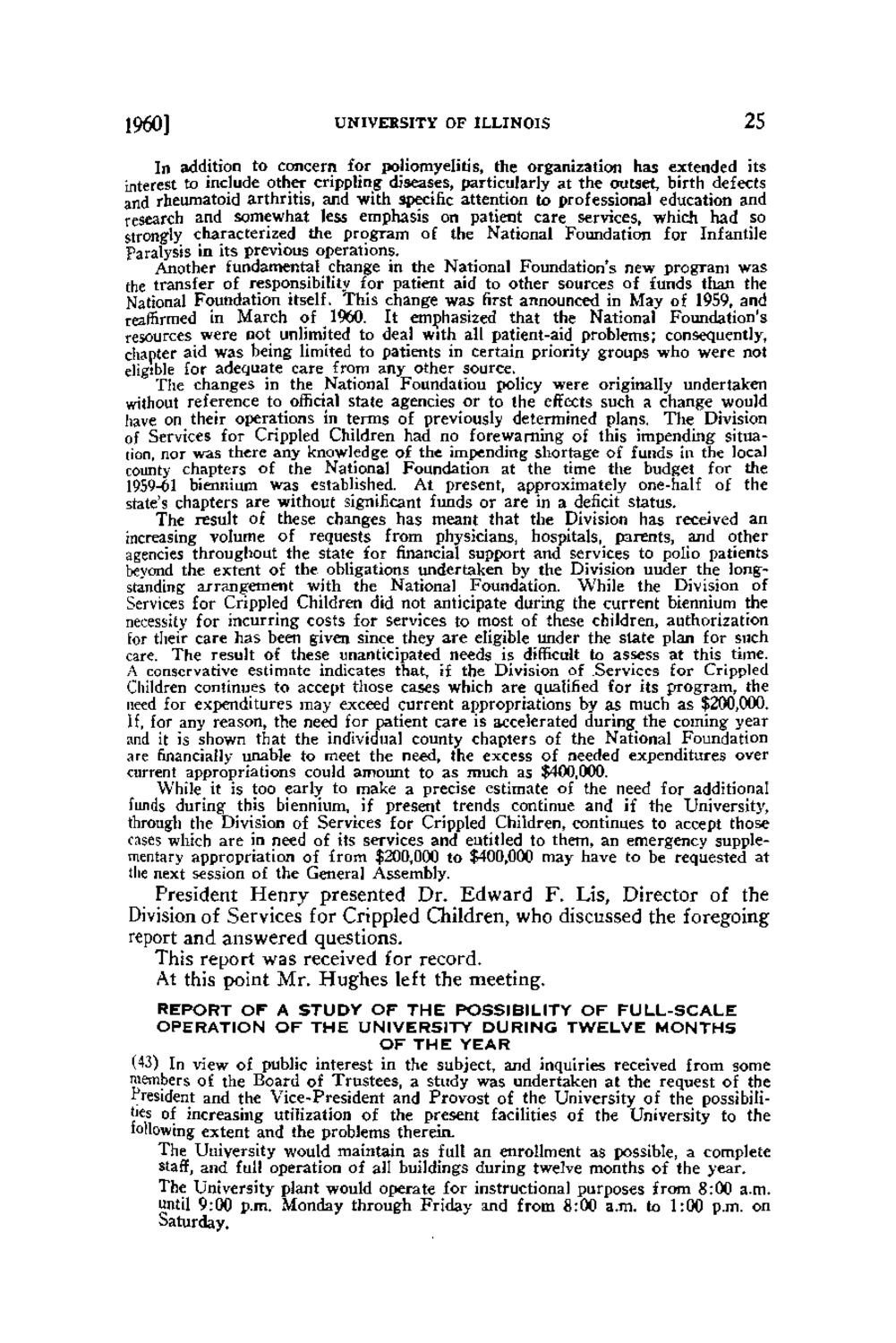| |
| |
Caption: Board of Trustees Minutes - 1962
This is a reduced-resolution page image for fast online browsing.

EXTRACTED TEXT FROM PAGE:
1960] UNIVERSITY OF ILLINOIS 25 In addition to concern for poliomyelitis, the organization has extended its interest to include other crippling diseases, particularly at the outset, birth defects and rheumatoid arthritis, and with specific attention to professional education and research and somewhat less emphasis on patient care services, which had so Strongly characterized the program of the National Foundation for Infantile Paralysis in its previous operations. Another fundamental change in the National Foundation's new prcgTam was the transfer of responsibility for patient aid to other sources of funds tlian the National Foundation itself. This change was first announced in May of 1959, and reaffirmed in March of 1960. It emphasized that the National Foundation's resources were not unlimited to deal with all patient-aid problems; consequently, chapter aid was being limited to patients in certain priority groups who were not eligible for adequate care from any other source. The changes in the National Foundation policy were originally undertaken without reference to official state agencies or to the effects such a change would liave on their operations in terms of previously determined plans. The Division of Services for Crippled Children had no forewarning of this impending situation, nor was there any knowledge of the impending shortage of funds in the local county chapters of the National Foundation at the time the budget for the 1959^61 bieniiium was established. At present, approximately one-half of the state's chapters are without significant funds or are in a deficit status. The result of these changes has meant that the Division has received an increasing volume of requests from physicians, hospitals, parents, and other agencies throughout the state for financial support and services to polio patients beyond the extent of the obligations undertaken by the Division uuder the longstanding arrangement with the National Foundation. While the Division of Services for Crippled Children did not anticipate during the current biennium the necessity for incurring costs for services to most of these children, authorization for their care has been given since they a r e eligible under the slate plan for such care. The result of these unanticipated needs is difficult to assess at this time. A conservative estimate indicates that, if the Division of Services for Crippled Children continues to accept those cases which are qualified for its program, the need for expenditures may exceed current appropriations by as much as $200,000. If, for any reason, the need for patient care is accelerated during the coining year and it is shown that the individual county chapters of the National Foundation are financially unable to meet the need, the excess of needed expenditures over current appropriations could amount to as much as $400,000. While it is too early to make a precise estimate of the need for additional funds during this biennium, if present trends continue and if the "University, through the Division of Services for Crippled Children, continues to accept those cases which are in need of its services and entitled to them, an emergency supplementary appropriation of from $200,000 to $400,000 may have to be requested at the next session of the General Assembly. President Henry presented Dr. Edward F. Lis, Director of the Division of Services for Crippled Children, who discussed the foregoing report and answered questions. This report was received for record. At this point Mr. Hughes left the meeting, REPORT O F A STUDY O F T H E POSSIBILITY O F FULL-SCALE OPERATION O F THE UNIVERSITY DURING TWELVE MONTHS O F T H E YEAR (43) In view of public interest in the subject, and inquiries received from some members of the Board of Trustees, a study was undertaken at the request of the President and the Vice-President and Provost of the University of the possibilities of increasing utilization of the present facilities of the University to the following extent and the problems therein. The University would maintain as full an enrollment as possible, a complete staff, and full operation of all buildings during twelve months of the year. The University plant would operate for instructional purposes from 8:00 a.m. until 9:00 p.m. Monday through Friday and from 8:00 a.m. to 1:00 p.m. on Saturday,
| |